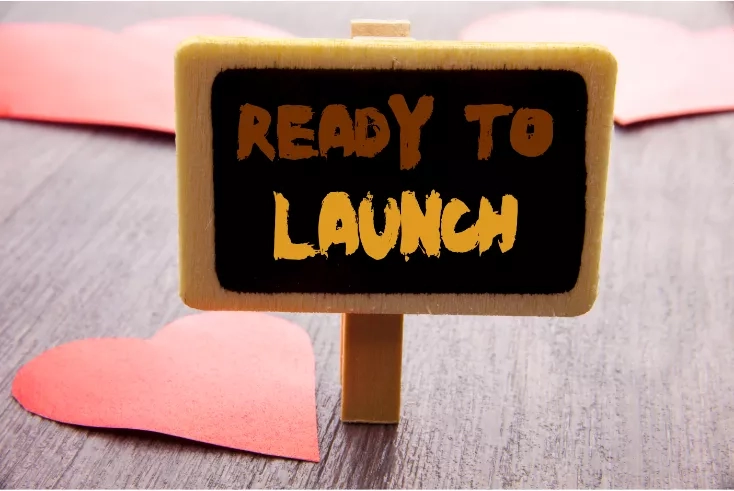According to Nielsen data, around 80% of newly launched Consumer Packaged Goods (CPG) products fail.
One theory for why it’s so difficult to see a new product in any industry sector take off is simply a lack of preparation.
When all of the hard work goes into the design and manufacturing, creating a marketing launch plan is often relegated down the "to-do list" and by the time it becomes a priority, it’s often too late.
With this in mind, here are three of the main reasons why a product launch marketing plan should be created early in the planning cycle:
- Driving consumer demand in advance of a product coming to market increases the "pull effect" by encouraging shoppers to start asking for the product and retailers to pre-order, thus "pulling" the product through their distribution channels.
- A successful product launch drives excitement, interest, and new business leads, which creates a sales funnel, where prospects, fans, and referrals can begin their journey towards purchase.
- Most CEOs believe that if only the market understood their new product, they’d buy it immediately. Developing a product narrative early could not only drive the marketing plan, it may also influence design or manufacturing.
Before we take you through how to create product launch event ideas, let’s look at what a product launch actually entails.
As the name suggests, it should be that moment in time when a new product offering is made available to the public for the first time. However, as we’ve outlined above, staging a launch in advance of the product being made available - and teasing the launch date as part of the plan - can significantly contribute to the ‘pull effect’ and drive consumer anticipation.
One of the best ways to launch a new product is with an event or series of teaser events.
By giving potential customers the opportunity to experience, touch, and feel the product in a face-to-face live environment, you’ll increase the word-of-mouth buzz across social media channels and drive purchase consideration by allowing shoppers to "test-drive" your product, learn how it’ll benefit their everyday lives and have all their questions answered.
So, where should you start with your product launch?
Consider the product narrative
By working closely with product designers from inception, marketers can begin to develop a product narrative that will help to create content marketing assets, advertising strap-lines, and social media collateral further down the line.
For example, is sustainability one of the core design principles? How is this reflected in the manufacturing supply chain? What are the stories behind how the product came to be and can you use these stories to bring your product to life in the market?
Build your audience
Use content marketing to drive more frequent traffic to your website. Product launch marketing is much easier if you already have returning online visitors, eager to discover new offers, read timely blogs and engage with your launch marketing campaign.
Increase your follower-base across all social media channels by promoting your content marketing assets, teasing a new product in development, and joining in the conversations relevant to your industry sector.
Identify influencers who can help drive interest and trust in your product. It doesn’t have to be an expensive social media celebrity with millions of followers if your product is for a niche market - it just needs to be persons or media brands that customers trust.
Host or sponsor some live events or virtual events in advance of your product launch date. These could feature interesting speakers to build your reputation as a thought-leader in the sector or align your brand with the leading exhibition or convention to increase awareness.
Review your email lists for lead magnates, open rates and, unsubscribes. Do this with a test e-newsletter to see how engaged your audience is in what you have to say. If you need to develop their engagement, plan a series of email bulletins in the months leading up to your launch.
Now you’re ready to create a product launch marketing plan
Follow these seven steps
Identify customer needs
You can’t prepare a good marketing strategy if you don't understand the requirements of your target customers. Conduct surveys and market research to understand what features in your product will appeal to users. You can ask them about the products they are currently using and why. You can question them on how much they are willing to pay for a product if it can solve their current needs. This way, you will get an idea about your competition, the needs of the users, plus you can also implement a suitable pricing strategy for your product.
Study your competition
Research SEO keywords, social media accounts, competitor content, and product reviews. Establish who is doing well, why they’re doing well, and what lessons you can learn from negative customer reviews. To build a social media strategy, pay attention to how often your competitors post, what kinds of content receive the most likes, and how they tell stories about their brand online.
Establish your USP
A product launch marketing strategy should highlight and promote your Unique Selling Proposition (USP) at every available opportunity. The USP should be based on four things:
- Customer needs
- Competitor offerings
- Distinctive product benefits
- Brand values/promise
Decide on your marketing channels
Consider both offline and online marketing channels to reach your desired audience. If your target audience is local, consider Out of Home advertising such as billboards, bus stops, and digital poster sites. If your target audience is country-wide or across multiple states, prioritize digital, TV, radio, or social media.
Be clear with your messaging
Explain your product to the target audience by including who your product is for and what kind of problem it solves. You should also discuss the product’s unique capabilities and how the product is different from other products in the same category segment.
For example, if you have a speaker who is endorsing your product, be sure they know how to talk about the product by briefing them thoroughly on your key marketing messages and advertising key phrases.
Test, test, and test again
Just as the product itself will be tested, make sure you test marketing creative, email marketing campaigns, advertising copy, social assets, CTAs, and website landing pages. Once the product goes live, all these marketing tools will come into play so you need to know they’re as effective as they can be.
Create a countdown
Creating a launch countdown is a tried-and-true method for building excitement around product launch planning. Post your launch countdown on your website and social media accounts. When customers visit your channels, they'll see reminders about the upcoming release.
When you successfully build social media hype for your product launch, you can keep this energy rolling after the launch event. Post your favorite photos from the event and repost pictures from your guests.
Launch with an event
Once you’ve understood your audience, developed your channel strategy, crafted the creative, and nurtured the narrative, it’s time to turn your attention to the launch event itself.
A launch event is an excellent way to showcase your latest product, build hype around it, and even acquire some sales right at the event. The more you can get people talking about the product, both at the event and via social media, the better it’s going to do.
Here are six tips to help you build an event into your product launch marketing strategy
1. Choose a venue that’s interesting but doesn’t outshine your product
Obviously, you want the emphasis to be on the product, not the venue. Nevertheless, a memorable venue will help to attract attendees. Try to associate the product with the venue. For instance, if you’re releasing new technology, opt for a modern high-tech venue that complements your product.
If your product caters to a local demographic, choose a venue that’s close to where your customers live. Don’t make people commute out of their way.
Here are a few other styles of event venues to align to your product brand values.
Creative: Unique designer spaces like cocktail bars, art galleries or restaurants will generate buzz and express the creativity of your brand.
Luxury: When launching a luxury product, choose a prestigious and elegant event venue, such as a stately home that evokes class and style.
Historic: If your brand has a long company legacy, highlight this history by hosting your product launch in a museum, town hall, or library.
Outdoors: A creative outdoor venue like a public garden, hotel courtyard or forest can attract large crowds while providing space for live performances and product demonstrations.
2. Make it exclusive
Product launch events should be built around two types of attendees. First, your customer base and followers, and second, those that can help promote your product be it the media, influencers, or industry experts.
Both play a huge part in making the event a success and that’s why you need to make it exclusive and special. For your customers, think about adding a personal touch with a product-related goody bag, special discount code, or VIP session.
Then for your media and influencer attendees, send out invitations and other goodies to get them on board well before the product launches. Discuss potential coverage, access to spokespeople, collaborations, teaser articles, and advertising options.
3. Choose a memorable, relevant theme for your product launch event
The theme should be relevant to the product, industry or time of year. If you’re launching in July for example, consider aligning your theme with Independence Day celebrations.
Or if you’re rolling out the red carpet in February, why not tap into an Oscars theme?
A word of warning though, don’t stray too far from the context of your product. Consumers are quick to pick-up on inauthenticity and if they suspect you’re hanging your event on a theme just to attract publicity, you may find yourself on the wrong end of a public backlash.
4. Entertain as well as inform
Your product launch event ideas, should, first and foremost, be informational and educational at their core. To leave guests with a lasting memory and an excuse to talk about the event across social media, however, it’s always good to entertain as well.
Options for event entertainment are extensive so make sure you’ve done your research and seen first-hand the act you’re considering booking.
The type of entertainment needs to align with your company’s brand values and product narrative, as well as your audience’s expectations so don’t leave anything to chance.
You could also incorporate entertainment elements that let customers interact with your new product directly.
Interactive brand activations for product launches allow customers to experience your product in a hands-on and engaging way. When you create an experiential event, you are more likely to build brand loyalty and positive product sentiment.
5. Pick the correct date to go live
When should you hold the event? Product launches (or virtual product launches) can be held on the day the product is released or as a teaser several days before the release.
Remember, don’t hold it too early; you want the anticipation to be at its peak when the product is released. While there’s no set rule, try to hold the event no more than two weeks before the release date.
Product launches as a whole should also be timed according to the time of year.
Perhaps the product makes for an excellent Christmas gift. If so, then make the product launch a holiday event. You can also explore industry-specific holidays or explore times of the year when the industry sees a peak in activity.
These are the optimal times for hosting your launch.
6. Have a plan for post-event follow-up
After a few days, the hype will die down. The day after the event though, presents a window of opportunity to keep the hype going just a bit longer and convert any leads who didn't buy during the event.
Use the same strategies you did for the pre-event marketing. This includes lots of social media activity, continuing use of the event hashtag, and sending out newsletters.
If sales of the product did not meet expectations, then offer some sort of incentive — a trial offer, rebate, or complimentary add-ons.
So there you have it.
For the best chance of success for your new product, start early by building your audience, testing your channels, developing the narrative and planning your event.
Once you’ve built hype and expectation amongst your target demographic, deliver a memorable experience that will have them talking about your product launch for months afterwards.








